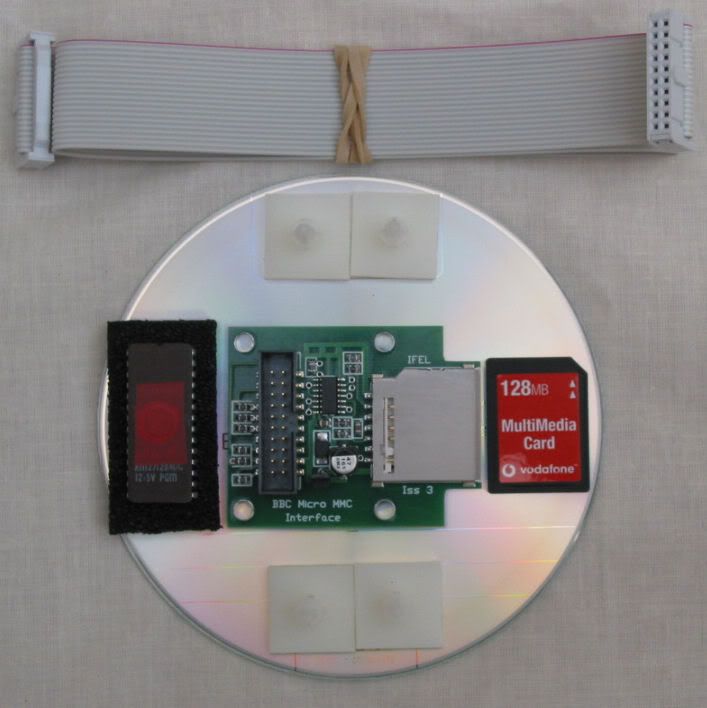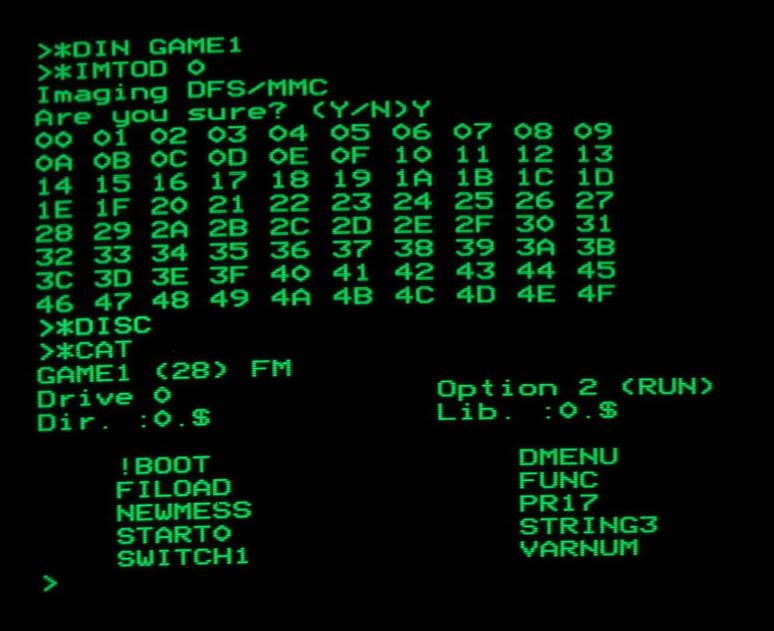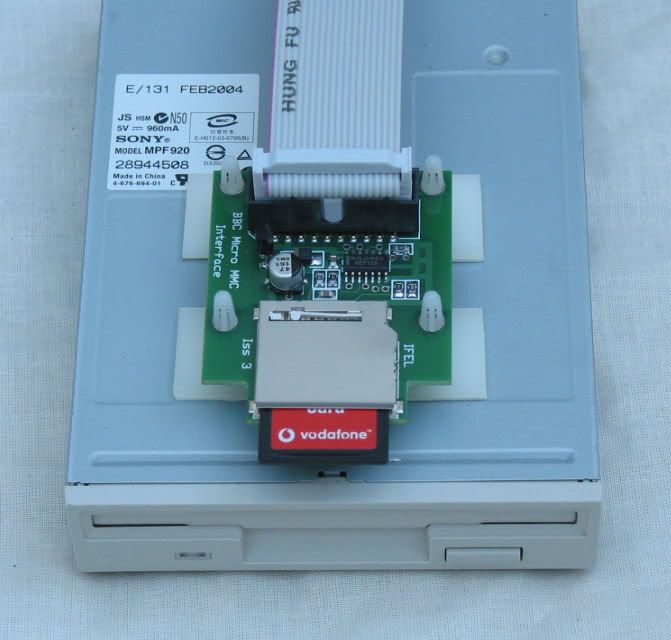
This upgrade will allow you to attach solid state storage to your BBC Micro
- Fast, reliable data storage for BBC Micro
- Suits BBC Model B, B+ and Master.
- Professionally made PCB
- 128MB MMC card included
- Turbo MMC ROM loads and saves data typically three times faster
- Can be mounted internally or externally
- Hot-swappable cards
- Draws its power from the User Port - no PSU required
- 1 year guarantee
This kit has to be one of the easiest ways to add solid state memory storage to your BBC Micro and probably the best value too. Everything you need to get started is provided, including a 128MB memory card. The main parts of this kit are shown below.

The green interface board itself measures about 1.9" by 2.4". One end of the ribbon cable (at the top) plugs into this interface and the other end into the User Port on the underside of the computer. The ribbon cable and 20-way connectors are completely standard so it is easy to make up another of a different length if required.
The software required to load and save data to the memory card
is provided on a 16kB EPROM although the code can also be put into some kind of
sideways RAM system too (ideally non-volatile). This software will typically
load and save files around three times quicker than the standard version. It is not
necessary to have a floppy disk system fitted in order to install this kit so it can be installed on a basic 'cassette tape only' machine.
The four square objects are self-adhesive pillars which are ideal for attaching the interface to the underside of the lid if an internal installation is preferred.
The memory card itself just slides into the socket on the interface board. It is permissible to swap cards around with the machine turned on and a 128MB memory card is included with the kit so you can get started right away. Each 128MB MMC card can hold the equivalent of a maximum of 511 80-track single-sided disks (about 300 disks on a 64MB card), but of course there is no limit to the number of MMC cards that you can have available.
DFS and ADFS disk transfer software included
One of the first things that you'll probably want to do is transfer your old 5.25" or 3.5" disks to the new flash memory system. Software is provided to do this, and in many cases you can just place the source disk in your normal drive (both 5.25" and 3.5" are suitable), load the required program and type the required 'star' command. *MTOD copies DFS files from the MMC system to a floppy drive and *DTOM copies in the other direction. *ATOM copies from an ADFS drive (floppies and conventional hard drive) to the MMC and *MTOA copies in the other direction. Please note that the software uses only standard filing system calls and is not intended to defeat copy protection on disks. Additionally, it may not be possible to copy files from disks which have deteriorated over time and become corrupted or otherwise unreadable. As a general rule, if the disk cannot be verified without causing errors then you may well have problems copying some (or all) of the files on it.
Handling SSD images
It is possible to download SSD images from the internet. These can be thought of as a single file that represents a complete single sided 80 track disk (SSD). The MMC card provided could contain around 500 such SSDs and the programs that each one contains would normally be run directly from the MMC interface. You can, however, very easily make a copy of an SSD to a real floppy disk if required or indeed create an SSD from any of your floppies.
For example, below you can see the method of creating a floppy disk from an SSD. The process starts by typing *DIN followed by the name of the SSD required. You then enter *IMTOD and this is the command to make an image from the MMC to a floppy disk. You also have to include the floppy drive number, 0 in this case. Drives 0, 1, 2 and 3 can all be used if you wish.
After the 'Y' confirmation you can see the machine printing out the track numbers (0 to hex 4F or 79 decimal) as the imaging progresses. The total time taken for this will vary with drive settings and the type of DFS you are using but with the Master 128 used here it is about 32 seconds.
Finally, the Disk Filing System is selected with *DISC and a
catalogue requested for the newly created floppy.

Use internally or externally
Some solid state memory systems for the Beeb are intended to be used either externally or internally, but not both. In other words, the internal version cannot be readily converted for external use and vice versa. They also need their own power supply.
No separate power supply is needed with this system because power is drawn from the User Port through the ribbon cable, about 8mA when idle and this rises to around 30mA when loading or saving data. It's equally at home as an internal or external arrangement.
Hot-swappable
The cards can be considered to be hot-swappable in that you don't have to turn the computer off when inserting or removing them. In practice it's a real boon, particularly with an external interface. Cards can be swapped between your Beeb and a PC in a matter of seconds, or merely change one card for a different one. The Beeb will require little more than a Ctrl-Break whenever a new card is inserted.
How much memory?
It its day, there was no reason not to use the Beeb for a small business. In fact, our very first VAT returns were done on BeebCalc and most letters on Wordwise. But fine machine though it is, technology has moved on. With free programs like Open Office running under Windows not many users would prefer to use a BBC Micro for spreadsheets and word-processing.
But in terms of adding extra hardware to its various expansion ports and as a learning environment for the 6502 microprocessor, the Beeb just about reigns supreme. When adding solid state storage it's very easy to get carried away with the belief that you need hundreds of megabytes available. In reality, you don't. For example, the source code for Wordwise Plus, one of the most popular word-processing packages ever produced for the BBC Micro, occupied just one 80-track disk. The 128MB memory card supplied with this kit will allow you to have over 500 80-track disks at your disposal. In the unlikely event that you need them, additional MMC cards are very inexpensive.
How fast?
For the tests here, a standard model B fitted with an 8271 based disk upgrade was used. Four filing systems are compared, a 3.5" DFS floppy disk, a Compact Flash system on the 1MHz bus, Super MMC on the User Port, and finally this product (Turbo MMC) also on the User Port. For the LOAD test, the time taken to *LOAD a 16kB file into memory was measured. The SAVE test involves saving a 16kB block of RAM to the filing system.
(Note that floppy drive results can be greatly affected by the drive step time and also the location of the file on the disk. The times shown for the floppy drive indicate the time spent actually loading the file and ignore the time taken to locate it. So in practice, loading/saving a file from/to a floppy disk will often be much slower than the times shown below.)
Test 1: *LOAD a 16kB file into RAM (times in seconds)

Test 2: *SAVE a 16kB block of data (times in seconds)

As the results show, despite being the most inexpensive system around this solid state storage upgrade for the Beeb is faster than some systems costing considerably more.
Tutorials
The CD contains instructions on how to prepare new MMC cards for use with the interface and of course installation and using the product generally. Topics covered include how to create and use !Boot files and getting ROM images, widely available on the internet, onto the MMC card. Such images can then be quickly loaded into sideways RAM (where fitted) by a !Boot file.
The photo below shows what a typical external arrangement might look like. Internal installations are also possible. Please note that the floppy disk drive is not included in the sale.

Money-back guarantee
The product is covered by a 1 year guarantee. Additionally, most eBay Buy It Now sales are covered by the Distance Selling Regulations (DSR). In essence this gives you a 7-day period in which to return the goods for any reason whatsoever. If you wish to return this item in the 7-day period then you will receive a full refund (cost of the item itself and the postage too). The cost of returning the item to us is to be borne by the purchaser unless, of course, the item is actually faulty in which case we will refund any reasonable postage costs as well.
For UK buyers this offer is extended further. You can return the item in good condition for any reason whatsoever within 7 days for a full no-quibble refund. Not only do we refund the full amount paid but also the return postage (first or second class standard). What do you have to lose by checking it out?